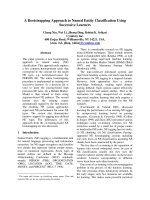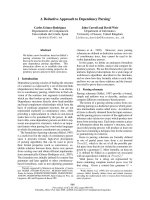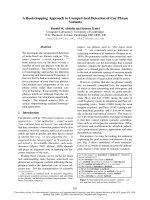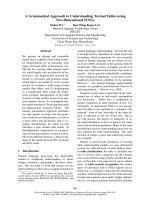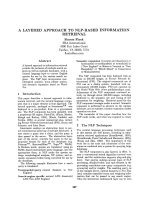Báo cáo khoa học: "A Syntax-Free Approach to Japanese Sentence Compression" potx
Bạn đang xem bản rút gọn của tài liệu. Xem và tải ngay bản đầy đủ của tài liệu tại đây (498.53 KB, 8 trang )
Proceedings of the 47th Annual Meeting of the ACL and the 4th IJCNLP of the AFNLP, pages 826–833,
Suntec, Singapore, 2-7 August 2009.
c
2009 ACL and AFNLP
A Syntax-Free Approach to Japanese Sentence Compression
Tsutomu HIRAO, Jun SUZUKI and Hideki ISOZAKI
NTT Communication Science Laboratories, NTT Corp.
2-4 Hikaridai, Seika-cho, Soraku-gun, Kyoto 619-0237 Japan
{hirao,jun,isozaki}@cslab.kecl.ntt.co.jp
Abstract
Conventional sentence compression meth-
ods employ a syntactic parser to compress
a sentence without changing its mean-
ing. However, the reference compres-
sions made by humans do not always re-
tain the syntactic structures of the original
sentences. Moreover, for the goal of on-
demand sentence compression, the time
spent in the parsing stage is not negligi-
ble. As an alternative to syntactic pars-
ing, we propose a novel term weighting
technique based on the positional infor-
mation within the original sentence and
a novel language model that combines
statistics from the original sentence and a
general corpus. Experiments that involve
both human subjective evaluations and au-
tomatic evaluations show that our method
outperforms Hori’s method, a state-of-the-
art conventional technique. Because our
method does not use a syntactic parser, it
is 4.3 times faster than Hori’s method.
1 Introduction
In order to compress a sentence while retaining
its original meaning, the subject-predicate rela-
tionship of the original sentence should be pre-
served after compression. In accordance with this
idea, conventional sentence compression methods
employ syntactic parsers. English sentences are
usually analyzed by a full parser to make parse
trees, and the trees are then trimmed (Knight and
Marcu, 2002; Turner and Charniak, 2005; Unno
et al., 2006). For Japanese, dependency trees are
trimmed instead of full parse trees (Takeuchi and
Matsumoto, 2001; Oguro et al., 2002; Nomoto,
2008)
1
This parsing approach is reasonable be-
cause the compressed output is grammatical if the
1
Hereafter, we refer these compression processes as “tree
trimming.”
input is grammatical, but it offers only moderate
compression rates.
An alternative to the tree trimming approach
is the sequence-oriented approach (McDonald,
2006; Nomoto, 2007; Clarke and Lapata, 2006;
Hori and Furui, 2003). It treats a sentence as a se-
quence of words and structural information, such
as a syntactic or dependency tree, is encoded in
the sequence as features. Their methods have the
potential to drop arbitrary words from the original
sentence without considering the boundary deter-
mined by the tree structures. However, they still
rely on syntactic information derived from fully
parsed syntactic or dependency trees.
We found that humans usually ignored the syn-
tactic structures when compressing sentences. For
example, in many cases, they compressed the sen-
tence by dropping intermediate nodes of the syn-
tactic tree derived from the source sentence. We
believe that making compression strongly depen-
dent on syntax is not appropriate for reproducing
reference compressions. Moreover, on-demand
sentence compression is made problematic by the
time spent in the parsing stage.
This paper proposes a syntax-free sequence-
oriented sentence compression method. To main-
tain the subject-predicate relationship in the com-
pressed sentence and retain fluency without us-
ing syntactic parsers, we propose two novel fea-
tures: intra-sentence positional term weighting
(IPTW) and the patched language model (PLM).
IPTW is defined by the term’s positional informa-
tion in the original sentence. PLM is a form of
summarization-oriented fluency statistics derived
from the original sentence and the general lan-
guage model. The weight parameters for these
features are optimized within the Minimum Clas-
sification Error (MCE) (Juang and Katagiri, 1992)
learning framework.
Experiments that utilize both human subjective
and automatic evaluations show that our method is
826
センタ試験 で
公表 し て い な
枝問 部分 の
Source Sentence
推定 し た
が福武配点 について
センタ試験枝問 の
Chunk 1
Chunk 2 Chunk 3
Chunk 4
Chunk 5
Chunk 6
Chunk 7
Compressed Sentence
Chunk7 = a part of Chunk6 + parts of Chunk4
センタ試験
枝問
の
suitei shi ta
haiten nitsuite fukutake ga
edamon bubun no
kouhyou shi te nai
center shiken de
推定 し た
が福武配点 について
Chunk 1
Chunk 2 Chunk 3
suitei shi ta
haiten nitsuite fukutake ga
center shiken
edamon no
edamon no
center shiken
Compression
compound noun
i
Figure 1: An example of the dependency relation between an original sentence and its compressed
variant.
superior to conventional sequence-oriented meth-
ods that employ syntactic parsers while being
about 4.3 times faster.
2 Analysis of reference compressions
Syntactic information does not always yield im-
proved compression performance because humans
usually ignore the syntactic structures when they
compress sentences. Figure 1 shows an exam-
ple. English translation of the source sentence is
“Fukutake Publishing Co., Ltd. presumed prefer-
ential treatment with regard to its assessed scores
for a part of the questions for a series of Center
Examinations.” and its compression is “Fukutake
presumed preferential scores for questions for a
series of Center Examinations.”
In the figure, each box indicates a syntactic
chunk, bunsetsu. The solid arrows indicate de-
pendency relations between words
2
. We observe
that the dependency relations are changed by com-
pression; humans create compound nouns using
the components derived from different portions of
the original sentence without regard to syntactic
constraints. ‘Chunk 7’ in the compressed sen-
tence was constructed by dropping both content
and functional words and joining other content
words contained in ‘Chunk 4’ and ‘Chunk 6’ of
2
Generally, a dependency relation is defined between bun-
setsu. Therefore, in order to identify word dependencies, we
followed Kudo’s rule (Kudo and Matsumoto, 2004)
the original sentence. ‘Chunk 5’ is dropped com-
pletely. This compression cannot be achieved by
tree trimming.
According to an investigation in our corpus of
manually compressed Japanese sentences, which
we used in the experimental evaluation, 98.7% of
them contain at least one segment that does not
retain the original tree structure. Human usually
compress sentences by dropping the intermediate
nodes in the dependency tree. However, the re-
sulting compressions retain both adequacy and flu-
ency. This statistic supports the view that sentence
compression that strongly depends on syntax is
not useful in reproducing reference compressions.
We need a sentence compression method that can
drop intermediate nodes in the syntactic tree ag-
gressively beyond the tree-scoped boundary.
In addition, sentence compression methods that
strongly depend on syntactic parsers have two
problems: ‘parse error’ and ‘decoding speed.’
44% of sentences output by a state-of-the-art
Japanese dependency parser contain at least one
error (Kudo and Matsumoto, 2005). Even more, it
is well known that if we parse a sentence whose
source is different from the training data of the
parser, the performance could be much worse.
This critically degrades the overall performance
of sentence compression. Moreover, summariza-
tion systems often have to process megabytes of
documents. Parsers are still slow and users of on-
827
demand summarization systems are not prepared
to wait for parsing to finish.
3 A Syntax Free Sequence-oriented
Sentence Compression Method
As an alternative to syntactic parsing, we pro-
pose two novel features, intra-sentence positional
term weighting (IPTW) and the patched language
model (PLM) for our syntax-free sentence com-
pressor.
3.1 Sentence Compression as a
Combinatorial Optimization Problem
Suppose that a compression system reads sen-
tence x= x
1
,x
2
, , x
j
, , x
N
,wherex
j
is the j-th word in the input sentence. The
system then outputs the compressed sentence y
=y
1
,y
2
, ,y
i
, , y
M
,wherey
i
is the i-
th word in the output sentence. Here, y
i
∈
{x
1
, ,x
N
}. We assume y
0
=x
0
=<s> (BOS)
and y
M+1
=x
N+1
=</s> (EOS). We define func-
tion I(·), which maps word y
i
to the index of
the word in the original sentence. For example,
if source sentence is x = x
1
,x
2
, ,x
5
and its
compressed variant is y = x
1
,x
3
,x
4
, I(y
1
)=1,
I(y
2
)=3, I(y
3
)=4.
We define a significance score f(x, y, Λ) for
compressed sentence y based on Hori’s method
(Hori and Furui, 2003). Λ = {λ
g
, λ
h
} is a pa-
rameter vector.
f(x, y; Λ)=
M+1
i=1
{g(x,I(y
i
); λ
g
)+
h(x,I(y
i
),I(y
i−1
); λ
h
)} (1)
The first term of equation (1) (g(·)) is the impor-
tance of each word in the output sentence, and the
second term (h(·)) is the the linguistic likelihood
between adjacent words in the output sentence.
The best subsequence
ˆ
y=argmax
y
f(x, y; Λ) is
identified by dynamic programming (DP) (Hori
and Furui, 2003).
3.2 Features
We use IPTW to define the significance score
g(x,I(y
i
); λ
g
). Moreover, we use PLM to define
the linguistic likelihood h(x,I(y
i+1
),I(y
i
); λ
h
).
3.2.1 Intra-sentence Positional Term
Weighting (IPTW)
IDF is a global term weighting scheme in that it
measures the significance score of a word in a
text corpus, which could be extremely large. By
contrast, this paper proposes another type of term
weighting; it measures the positional significance
score of a word within its sentence. Here, we as-
sume the following hypothesis:
• The “significance” of a word depends on its
position within its sentence.
In Japanese, the main subject of a sentence
usually appears at the beginning of the sentence
(BOS) and the main verb phrase almost always
appears at the end of the sentence (EOS). These
words or phrases are usually more important than
the other words in the sentence. In order to
add this knowledge to the scoring function, term
weight is modeled by the following Gaussian mix-
ture.
N(psn(x,I(y
i
)); λ
g
)=
m
1
1
√
2πσ
1
exp
−
1
2
psn(x,I(y
i
)) − μ
1
σ
1
2
+
m
2
1
√
2πσ
2
exp
−
1
2
psn(x,I(y
i
)) − μ
2
σ
2
2
(2)
Here, λ
g
= {μ
k
,σ
k
,m
k
}
k=1,2
. psn(x,I(y
i
))
returns the relative position of y
i
in the original
sentence x which is defined as follows:
psn(x,I(y
i
)) =
start(x,I(y
i
))
length(x)
(3)
‘length(x)’ denotes the number of characters in
the source sentence and ‘start(x,I(y
i
))’ denotes
the accumulated run of characters from BOS to
(x,I(y
i
)). In equation (2), μ
k
,σ
k
indicates the
mean and the standard deviation for the normal
distribution, respectively. m
k
is a mixture param-
eter.
We use the distribution (2) in defining
g(x,I(y
i
); λ
g
) as follows:
g(x,I(y
i
); λ
g
)=
⎧
⎪
⎪
⎨
⎪
⎪
⎩
IDF(x,I(y
i
)) × N(psn(x,I(y
i
); λ
g
)
if pos(x,I(y
i
)) = noun, verb, adjective
Constant × N(psn(x,I(y
i
); λ
g
)
otherwise
(4)
828
Here, pos(x,I(y
i
)) denotes the part-of-speech tag
for y
i
. λ
g
is optimized by using the MCE learning
framework.
3.2.2 Patched Language Model
Many studies on sentence compression employ the
n-gram language model to evaluate the linguistic
likelihood of a compressed sentence. However,
this model is usually computed by using a huge
volume of text data that contains both short and
long sentences. N-gram distribution of short sen-
tences may different from that of long sentences.
Therefore, the n-gram probability sometimes dis-
agrees with our intuition in terms of sentence com-
pression. Moreover, we cannot obtain a huge
corpus consisting solely of compressed sentences.
Even if we collect headlines as a kind of com-
pressed sentence from newspaper articles, corpus
size is still too small. Therefore, we propose
the following novel linguistic likelihood based on
statistics derived from the original sentences and a
huge corpus:
PLM(x,I(y
j
),I(y
j−1
)) =
⎧
⎨
⎩
1 if I(y
j
)=I(y
j−1
)+1
λ
PLM
Bigram(x,I(y
j
),I(y
j−1
))
otherwise
(5)
PLM stands for Patched Language Model.
Here, 0 ≤ λ
PLM
≤ 1, Bigram(·) indicates word
bigram probability. The first line of equation (5)
agrees with Jing’s observation on sentence align-
ment tasks (Jing and McKeown, 1999); that is,
most (or almost all) bigrams in a compressed sen-
tence appear in the original sentence as they are.
3.2.3 POS bigram
Since POS bigrams are useful for rejecting un-
grammatical sentences, we adopt them as follows:
P
pos
(x,I(y
i+1
)|I(y
i
)) =
P (pos(x,I(y
i+1
))|pos(x,I(y
i
))). (6)
Finally, the linguistic likelihood between adja-
cent words within y is defined as follows:
h(x,I(y
i+1
),I(y
i
); λ
h
)=
PLM(x,I(y
i+1
),I(y
i
)) +
λ
(pos(x,I(y
i+1
))|pos(x,I(y
i
)))
P
pos
(x,I(y
i+1
)|I(y
i
))
3.3 Parameter Optimization
We can regard sentence compression as a two class
problem: we give a word in the original sentence
class label +1 (the word is used in the compressed
output) or −1 (the word is not used). In order to
consider the interdependence of words, we employ
the Minimum Classification Error (MCE) learning
framework (Juang and Katagiri, 1992), which was
proposed for learning the goodness of a sequence.
x
t
denotes the t-th original sentence in the training
data set T . y
∗
t
denotes the reference compression
that is made by humans and
ˆ
y
t
is a compressed
sentence output by a system.
When using the MCE framework, the misclas-
sification measure is defined as the difference be-
tween the score of the reference sentence and that
of the best non-reference output and we optimize
the parameters by minimizing the measure.
d(y, x; Λ)={
|T |
t=1
f(x
t
, y
∗
t
; Λ)
− max
ˆ
y
t
=y
∗
t
f(x
t
,
ˆ
y
t
; Λ)} (7)
It is impossible to minimize equation (7) because
we cannot derive the gradient of the function.
Therefore, we employ the following sigmoid func-
tion to smooth this measure.
L(d(x, y; Λ)) =
|T |
t=1
1
1 + exp(−c × d(x
t
, y
t
; Λ))
(8)
Here, c is a constant parameter. To minimize equa-
tion (8), we use the following equation.
∇L=
∂L
∂d
∂d
∂λ
1
,
∂d
∂λ
2
,
=0 (9)
Here,
∂L
∂d
is given by:
∂L
∂d
=
c
1 + exp (−c × d)
1 −
1
1+exp(−c × d)
(10)
Finally, the parameters are optimized by using
the iterative form. For example, λ
w
is optimized
as follows:
λ
w(new)
= λ
w(old)
−
∂L
∂λ
w(old)
(11)
829
Our parameter optimization procedure can be
replaced by another one such as MIRA (McDon-
ald et al., 2005) or CRFs (Lafferty et al., 2001).
The reason why we employed MCE is that it is
very easy to implement.
4 Experimental Evaluation
4.1 Corpus and Evaluation Measures
We randomly selected 1,000 lead sentences (a lead
sentence is the first sentence of an article exclud-
ing the headline.) whose length (number of words)
was greater than 30 words from the Mainichi
Newspaper from 1994 to 2002. There were five
different ideal compressions (reference compres-
sions produced by human) for each sentence; all
had a 0.6 compression rate. The average length of
the input sentences was about 42 words and that of
the reference compressions was about 24 words.
For MCE learning, we selected the reference
compression that maximize the BLEU score (Pap-
ineni et al., 2002) (=argmax
r∈R
BLEU(r, R\r))
from the set of reference compressions and used it
as correct data for training. Note that r is a ref-
erence compression and R is the set of reference
compressions.
We employed both automatic evaluation and hu-
man subjective evaluation. For automatic evalua-
tion, we employed BLEU (Papineni et al., 2002)
by following (Unno et al., 2006). We utilized 5-
fold cross validation, i.e., we broke the whole data
set into five blocks and used four of them for train-
ing and the remainder for testing and repeated the
evaluation on the test data five times changing the
test block each time.
We also employed human subjective evaluation,
i.e., we presented the compressed sentences to six
human subjects and asked them to evaluate the
sentence for fluency and importance on a scale 1
(worst) to 5 (best). For each source sentence, the
order in which the compressed sentences were pre-
sented was random.
4.2 Comparison of Sentence Compression
Methods
In order to investigate the effectiveness of the pro-
posed features, we compared our method against
Hori’s model (Hori and Furui, 2003), which is
a state-of-the-art Japanese sentence compressor
based on the sequence-oriented approach.
Table 1 shows the feature set used in our exper-
iment. Note that ‘Hori−’ indicates the earlier ver-
Table 1: Configuration setup
Label g() h()
Proposed IPTW PLM+POS
w/o PLM
IPTW Bigram+POS
w/o IPTW
IDF PLM+POS
Hori−
IDF Trigram
Proposed+Dep IPTW PLM + POS +Dep
w/o PLM+Dep
IPTW Bigram+POS+Dep
w/o IPTW+Dep
IDF PLM+POS+Dep
Hori
IDF Trigram+Dep
Table 2: Results: automatic evaluation
Label BLEU
Proposed .679
w/o PLM
.617
w/o IPTW
.635
Hori−
.493
Proposed+Dep .632
w/o PLM+Dep
.669
w/o IPTW+Dep
.656
Hori
.600
sion of Hori’s method which does not require the
dependency parser. For example, label ‘w/o IPTW
+ Dep’ employs IDF term weighting as function
g(·) and word bigram, part-of-speech bigram and
dependency probability between words as func-
tion h(·) in equation (1).
To obtain the word dependency probability, we
use Kudo’s relative-CaboCha (Kudo and Mat-
sumoto, 2005). We developed the n-gram lan-
guage model from a 9 year set of Mainichi News-
paper articles. We optimized the parameters by
using the MCE learning framework.
5 Results and Discussion
5.1 Results: automatic evaluation
Table 2 shows the evaluation results yielded by
BLUE at the compression rate of 0.60.
Without introducing dependency probability,
both IPTW and PLM worked well. Our method
achieved the highest BLEU score. Compared to
‘Proposed’, ‘w/o IPTW’ offers significantly worse
performance. The results support the view that our
hypothesis, namely that the significance score of
a word depends on its position within a sentence,
is effective for sentence compression. Figure 2
shows an example of Gaussian mixture with pre-
830
0
0.05
0.1
0.15
0.2
0 N/4 N/2 3N/4 N
x
1
,x
2
,,x
j
,,x
N
<S>
</S>
x
Figure 2: An example of Gaussian mixture with
predicted parameters
dicted parameters. From the figure, we can see
that the positional weights for words have peaks
at BOS and EOS. This is because, in many cases,
the subject appears at the beginning of Japanese
sentences and the predicate at the end.
Replacing PLM with the bigram language
model (w/o PLM) degrades the performance sig-
nificantly. This result shows that the n-gram lan-
guage model is improper for sentence compres-
sion because the n-gram probability is computed
by using a corpus that includes both short and long
sentences. Most bigrams in a compressed sentence
followed those in the source sentence.
The dependency probability is very helpful pro-
vided either IPTW or PLM is employed. For ex-
ample, ‘w/o PLM + Dep’ achieved the second
highest BLEU score. The difference of the score
between ‘Proposed’ and ‘w/o PLM + Dep’ is only
0.01 but there were significant differences as de-
termined by Wilcoxon signed rank test. Compared
to ‘Hori−’, ‘Hori’ achieved a significantly higher
BLEU score.
The introduction of both IPTW and PLM makes
the use of dependency probability unnecessary. In
fact, the score of ‘Proposed + Dep’ is not good.
We believe that this is due to overfitting. PLM
is similar to dependency probability in that both
features emphasize word pairs that occurred as
bigrams in the source sentence. Therefore, by
introducing dependency probability, the informa-
tion within the feature vector is not increased even
though the number of features is increased.
Table 3: Results: human subjective evaluations
Label Fluency Importance
Proposed 4.05 (±0.846) 3.33 (±0.854)
w/o PLM + Dep
3.91 (±0.759) 3.24 (±0.753)
Hori−
3.09 (±0.899) 2.34 (±0.696)
Hori
3.28 (±0.924) 2.64 (±0.819)
Human 4.86 (±0.268) 4.66 (±0.317)
5.2 Results: human subjective evaluation
We used human subjective evaluations to compare
our method to human compression, ‘w/o PLM +
Dep’ which achieved the second highest perfor-
mance in the automatic evaluation, ‘Hori−’and
‘Hori’. We randomly selected 100 sentences from
the test corpus and evaluated their compressed
variants in terms of ‘fluency’ and ‘importance.’
Table 3 shows the results, mean score of all
judgements as well as the standard deviation.
The results indicate that human compression
achieved the best score in both fluency and impor-
tance. Human compression significantly outper-
formed other compression methods. This results
supports the idea that humans can easily compress
sentences with the compression rate of 0.6. Of
the automatic methods, our method achieved the
best score in both fluency and importance while
‘Hori−’ was the worst performer. Our method sig-
nificantly outperformed both ‘Hori’ and ‘Hori−’
on both metrics. Moreover, our method outper-
formed ‘w/o PLM + Dep’ again. However, the
differences in the scores are not significant. We
believe that this is due to a lack of data. If we use
more data for the significant test, significant dif-
ferences will be found. Although our method does
not employ any explicit syntactic information, its
fluency and importance are extremely good. This
confirms the effectiveness of the new features of
IPTW and PLM.
5.3 Comparison of decoding speed
We compare the decoding speed of our method
against that of Hori’s method.
We measured the decoding time for all 1,000
test sentences on a standard Linux Box (CPU:
Intel
c
Core
TM
2 Extreme QX9650 (3.00GHz),
Memory: 8G Bytes). The results were as follows:
Proposed: 22.14 seconds
(45.2 sentences / sec),
831
Hori: 95.34 seconds
(10.5 sentences / sec).
Our method was about 4.3 times faster than
Hori’s method due to the latter’s use of depen-
dency parser. This speed advantage is significant
when on-demand sentence compression is needed.
6 Related work
Conventional sentence compression methods em-
ploy the tree trimming approach to compress a
sentence without changing its meaning. For in-
stance, most English sentence compression meth-
ods make full parse trees and trim them by ap-
plying the generative model (Knight and Marcu,
2002; Turner and Charniak, 2005), discrimina-
tive model (Knight and Marcu, 2002; Unno et
al., 2006). For Japanese sentences, instead of us-
ing full parse trees, existing sentence compression
methods trim dependency trees by the discrim-
inative model (Takeuchi and Matsumoto, 2001;
Nomoto, 2008) through the use of simple lin-
ear combined features (Oguro et al., 2002). The
tree trimming approach guarantees that the com-
pressed sentence is grammatical if the source sen-
tence does not trigger parsing error. However, as
we mentioned in Section 2, the tree trimming ap-
proach is not suitable for Japanese sentence com-
pression because in many cases it cannot repro-
duce human-produced compressions.
As an alternative to these tree trimming
approaches, sequence-oriented approaches have
been proposed (McDonald, 2006; Nomoto, 2007;
Hori and Furui, 2003; Clarke and Lapata, 2006).
Nomoto (2007) and McDonald (2006) employed
the random field based approach. Hori et al.
(2003) and Clarke et al. (2006) employed the lin-
ear model with simple combined features. They
simply regard a sentence as a word sequence and
structural information, such as full parse tree or
dependency trees, are encoded in the sequence as
features. The advantage of these methods over the
tree trimming approach is that they have the poten-
tial to drop arbitrary words from the original sen-
tence without the need to consider the boundaries
determined by the tree structures. This approach is
more suitable for Japanese compression than tree
trimming. However, they still rely on syntactic
information derived from full parsed trees or de-
pendency trees. Moreover, their use of syntactic
parsers seriously degrades the decoding speed.
7 Conclusions
We proposed a syntax free sequence-oriented
Japanese sentence compression method with two
novel features: IPTW and PLM. Our method
needs only a POS tagger. It is significantly supe-
rior to the methods that employ syntactic parsers.
An experiment on a Japanese news corpus re-
vealed the effectiveness of the new features. Al-
though the proposed method does not employ any
explicit syntactic information, it outperformed,
with statistical significance, Hori’s method a state-
of-the-art Japanese sentence compression method
based on the sequence-oriented approach.
The contributions of this paper are as follows:
• We revealed that in compressing Japanese
sentences, humans usually ignore syntactic
structures; they drop intermediate nodes of
the dependency tree and drop words within
bunsetsu,
• As an alternative to the syntactic parser, we
proposed two novel features, Intra-sentence
positional term weighting (IPTW) and the
Patched language model (PLM), and showed
their effectiveness by conducting automatic
and human evaluations,
• We showed that our method is about 4.3 times
faster than Hori’s method which employs a
dependency parser.
References
J. Clarke and M. Lapata. 2006. Models for sentence
compression: A comparison across domains, train-
ing requirements and evaluation measures. In Proc.
of the 21st COLING and 44th ACL, pages 377–384.
C. Hori and S. Furui. 2003. A new approach to auto-
matic speech summarization. IEEE trans. on Multi-
media, 5(3):368–378.
H. Jing and K. McKeown. 1999. The Decomposition
of Human-Written Summary Sentences. In Proc. of
the 22nd SIGIR, pages 129–136.
B. H. Juang and S. Katagiri. 1992. Discriminative
Learning for Minimum Error Classification. IEEE
Trans. on Signal Processing, 40(12):3043–3053.
K. Knight and D. Marcu. 2002. Summarization be-
yond sentence extraction. Artificial Intelligence,
139(1):91–107.
832
T. Kudo and Y. Matsumoto. 2004. A Boosting Algo-
rithm for Classification of Semi-Structured Text. In
Proc. of the EMNLP, pages 301–308.
T. Kudo and Y. Matsumoto. 2005. Japanese De-
pendency Parsing Using Relative Preference of De-
pendency (in japanese). IPSJ Journal, 46(4):1082–
1092.
J. Lafferty, A. McCallum, and F. Pereira. 2001. Condi-
tional Random Fields: Probabilistic Models for Seg-
menting and Labeling Sequence Data. In Proc. of
the 18th ICML, pages 282–289.
R. McDonald, K. Crammer, and F. Pereira. 2005. On-
line Large Margrin Training of Dependency Parser.
In Proc. of the 43rd ACL, pages 91–98.
R. McDonald. 2006. Discriminative sentence com-
pression with soft syntactic evidence. In Proc. of
the 11th EACL, pages 297–304.
T. Nomoto. 2007. Discriminative sentence compres-
sion with conditional random fields. Information
Processing and Management, 43(6):1571–1587.
T. Nomoto. 2008. A generic sentence trimmer with
crfs. In Proc. of the ACL-08: HLT, pages 299–307.
R. Oguro, H. Sekiya, Y. Morooka, K. Takagi, and
K. Ozeki. 2002. Evaluation of a japanese sentence
compression method based on phrase significance
and inter-phrase dependency. In Proc. of the TSD
2002, pages 27–32.
K. Papineni, S. Roukos, T. Ward, and W-J. Zhu. 2002.
Bleu: a method for automatic evaluation of machine
translation. In Proc. of the 40th Annual Meeting of
the Association for Computational Linguistic (ACL),
pages 311–318.
K. Takeuchi and Y. Matsumoto. 2001. Acquisition
of sentence reduction rules for improving quality of
text summaries. In Proc. of the 6th NLPRS, pages
447–452.
J. Turner and E. Charniak. 2005. Supervised and un-
supervised learning for sentence compression. In
Proc. of the 43rd ACL, pages 290–297.
Y. Unno, T. Ninomiya, Y. Miyao, and J. Tsujii. 2006.
Trimming cfg parse trees for sentence compression
using machine learning approach. In Proc. of the
21st COLING and 44th ACL, pages 850–857.
833
